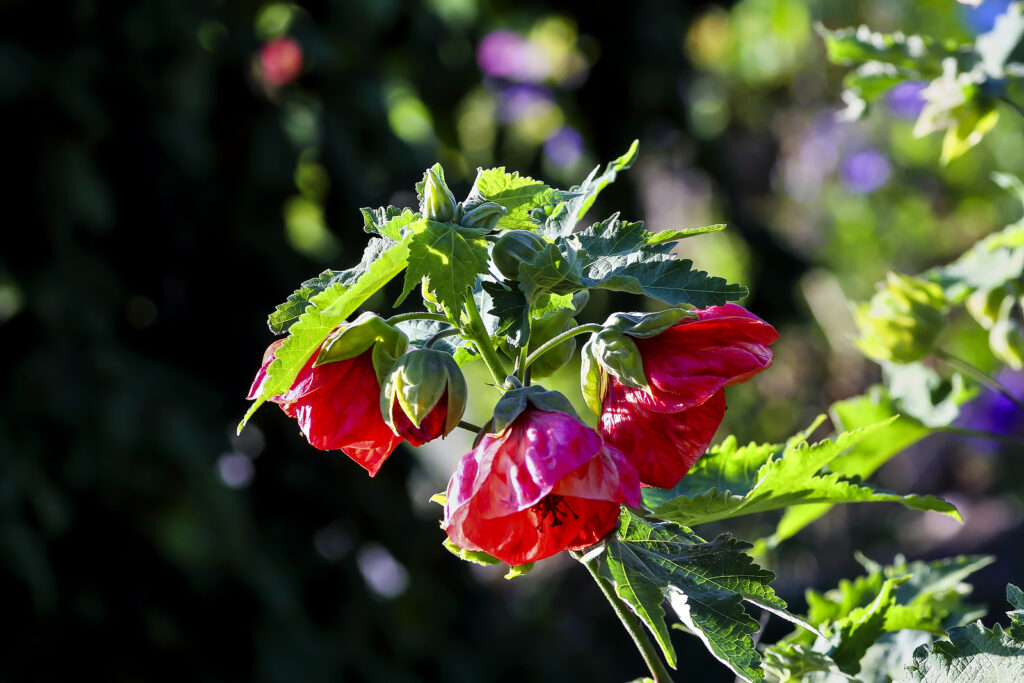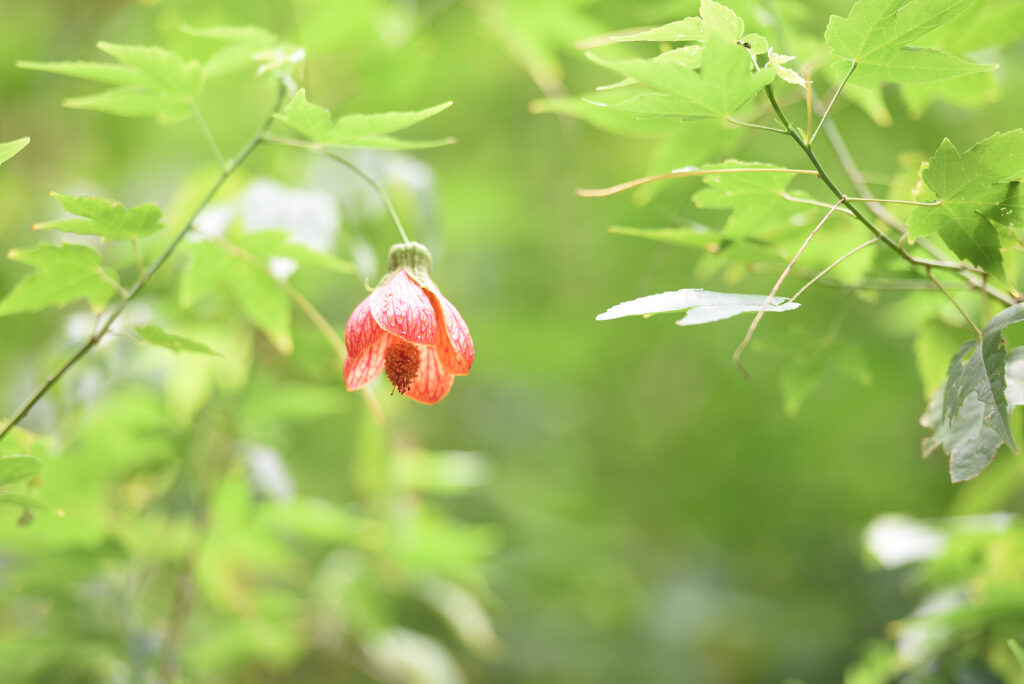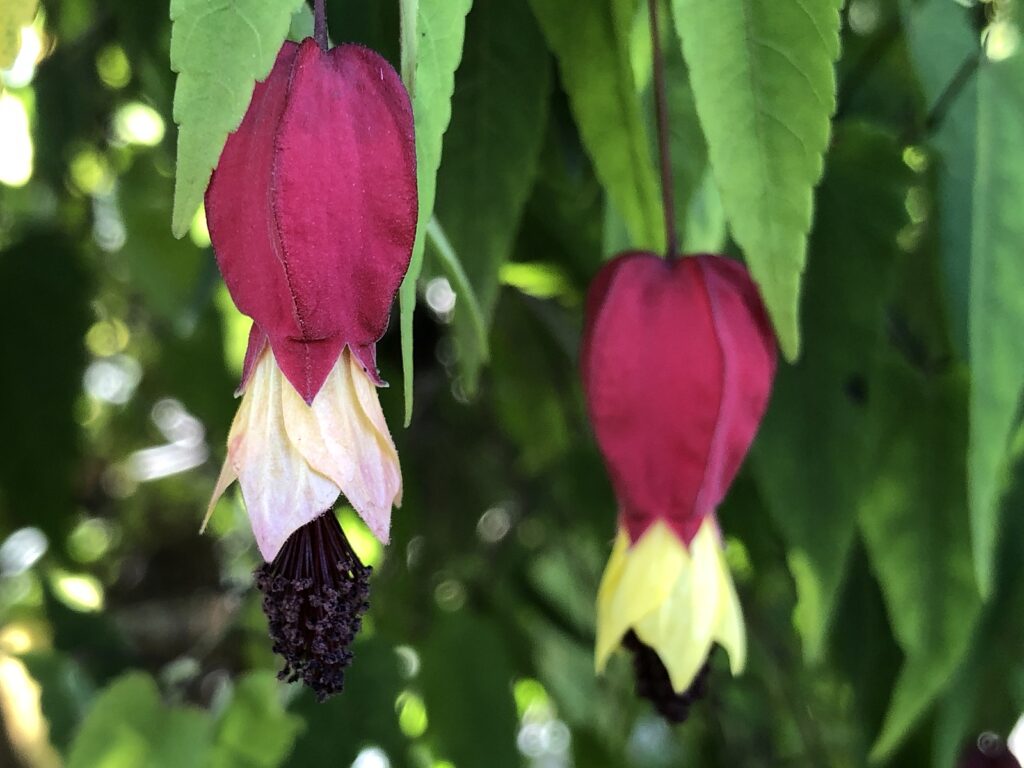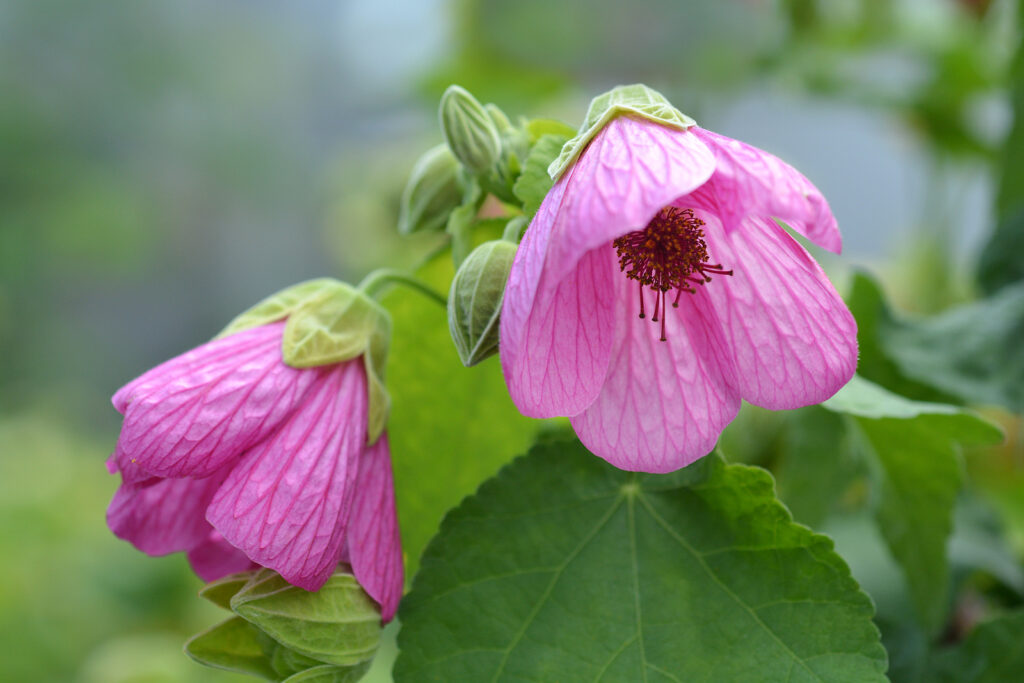Abutilon, flowering maple, is a mostly shade-lowing outdoor plant and a handsome house plant. It is content to live indoors all year if the right light is given. Outdoors Abutilon grows best where there is little to no frost in winter.
Abutilon has a multitude of flowers shaped like small hollyhocks. Flowers are pendulous, bell- or cup-shaped growing 2 to 3 inches (5-7.6cm) long and wide, sometimes larger. Flower colors include yellow, orange, red, pink, apricot, purple-red, and white.
Abutilon leaves are simple or lobed and maplelike–thus the common name flowering maple.
Abutilon is fast growing. For best flowering and to keep plants bushy, it is best to pinch back new growth once six leaves appear. Abutilon is best grown in a sheltered spot in the garden. Some species also can be grown in pots or hanging baskets.

Get to know Abutilon
- Plant type: Subtropical shrubs, small trees, and perennials
- Growing Zones and range: Zones 8 to 11 or indoors as a houseplant in colder regions
- Hardiness: Tender
- Optimal growing temperature: day 68° to 72°F (20° to 22°C), night 55° to 60°F (13°-16°C)
- Height and width: 5 feet (1.5m) tall and wide depending on growing conditions and pot size
- Foliage: Large, 3-inch (7cm) maplelike leaves in varying shades of green or variegated with white or yellow; look like small hibiscus flowers
- Flowers: 2- to 3-inch long and wide blooms in yellow, orange, red, pink, apricot, purple-red, and white.
- Bloom time: Spring through summer
- Uses: Grow as a houseplant; in mild-winter regions grow outdoors as a shrub
- Common name: Flowering maple, Chinese lantern, parlor maple
- Botanical name: Abutilon x hybridum and species
- Family: Malvaceae
- Origin: South America

Where to plant Abutilon
- Grow abutilon in full sun or partial shade; plants will bloom less and get leggy in lower light.
- Grow abutilon in humus-rich, well-drained soil.
- Where abutilon is marginally hardy, choose a site against a south-facing wall for winter protection.
- In cold-winter regions, grow abutilon in containers and overwinter them indoors in a bright, cool spot.
- Grown indoors, abutilon prefers average indoor temperatures (65° to 70°F/16°-21°C) and humidity; a difference of 10°F between day and night temperatures is ideal.
- Grow indoors in standard indoor potting soil.
- Abutilon prefers a soil pH of 5.5 to 6.3.
When to plant Abutilon
- Start abutilon from seed indoors in late winter or early spring. Sow seed 4 to 6 weeks before the last frost in spring.
- Start abutilon from softwood cuttings in autumn to set outdoors the following spring.
- Grow outdoors in subtropical regions. Indoors Abutilon should get 4 hours of direct sunlight each day.

Planting and spacing Abutilon
- Space abutilons 5 to 10 feet (1.5-3m) apart outdoors.
- Start seed or cutting indoors; plant in clean seed starting mix or potting soil. Keep the medium evenly moist at 65° to 70°F (18°-21°C) until plants are well-rooted.
- Sow seed 1/8 to 1/4 inch deep.
How to water and feed Abutilon
- Abutilon likes plenty of moisture; keep the soil evenly moist. Allow the soil to dry out somewhat between watering.
- Water abutilon deeply in dry weather.
- Fertilize with fish emulsion or liquid fertilizer diluted to half strength every 2 weeks. Withhold fertilizer during the autumn-through-winter rest period; also reduce watering, allowing the soil to dry completely between waterings.

Abutilon care
- Cut abutilon back by one-third in winter to ensure a bushier plant in spring.
- Repot in late winter if needed. Stake for upright growth.
- Abutilon is a vigorous, fast-growing plant; to produce bushy plants, pinch off the tips of growing branches frequently. Pinch heavily in autumn for better late winter and early spring bloom.
- Yellowing leaves are to be expected; remove them as they appear.
- Prune plants to shape in late winter or early spring; cut them back hard if they become rangy.
- Young plants bloom best; consider removing old plants when they become woody.
- In winter, protect Abutilon outdoors with straw or bracken.
Growing Abutilon as a houseplant
- Three species, Abutilon hybridum, A. megapotamicum, and A. pictum are often grown as houseplants.
- Grow Abutilon in direct light in a warm room that has medium humidity.
- Keep the growing medium evenly moist from spring to fall; allow the medium to dry out between waterings.
- Cut the stems back in spring before new growth stats, and pinch out growing tips to keep the plant compact.
- Fertilize Abutilon every two weeks when the plant is in growth is in flower.
- Repot in spring when necessary.
Pruning Abutilon
- Cut out frost-damaged and dead wood in spring.
- Cut back the previous season’s growth by two-thirds of their length.
- Pinch out the tips of free-standing specimens in the growing season if necessary to encourage bushiness.
Abutilon pests and diseases
- Scale, red spider mites, mealybugs, and whiteflies occasionally present a problem particularly when abutilon is grown indoors.
- Root-knot nematodes, leaf spots, and viruses can damage Abutilon.
Abutilon propagation
- Take tip cuttings at any time or grow plants from seed. Take cuttings in spring to propagate for garden use or in late summer to overwinter plants.
- Take cuttings every other year to grow new plants to replace old woody plants.
- Seeds from hybrids and cultivars will not grow true.
- Seeds germinate in 5 to 7 days at 65 to 70°F (18-21°C). Plants will be large enough for transplanting in 12 to 18 days. Flowers usually appear 14 to 17 weeks after sowing.

Abutilon varieties to grow
- Abutilon x hybridum, flowering maple. A shrubby plant can grow to 15 feet (4.5m) tall; bears pendent bell- to cup-shaped flowers in yellow, orange, red, or white; ovate to lobed, maplelike leaves may be variegated. Cultivars include: ‘Canary Bird’ which has yellow flowers; ‘Boule de Neige’ which has white flowers; ‘Fireball’ which has red flowers; ‘Souvenir de Bonn’ which has pink flowers.
- A. megapotamicum, trailing abutilon. Shrubby species is an evergreen that grows to 10 feet (3m) tall and wide with arching stems; needs frequent pinching so it does become rangy; the flowers resemble red and yellow lanterns. Cultivar ‘Variegata’ has mottled leaves.
- A. pictum. Has lobed leaves and flowers of yellow or yellow-orange, with deep red veins. Cultivar ‘Thompsonii’ bears pale orange flowers veined with red; foliage is variegated with creamy yellow; grows to 15 feet (4.5m) tall.
- A. vitifolium. A deciduous shrub grows to 15 feet (4.5m) tall; leaves are similar to grape leaves; saucer-shaped flowers can be white or lavender-blue and droop on long stalks.
Abutilon frequently asked questions
Q: I have a small plant with leaves that look like a maple. It produces orange-colored flowers like “Japanese lanterns” on dropping stems. What is it?
A: The plant is abutilon, often called flowering maple. It is hardy. It can be grown outdoors in Zones 9 and warmer, otherwise, it is a houseplant. It will flower in winter if grown at 50° to 60°F. It can be prepared by root cuttings.
Q: How do I grow abutilon flowering maple indoors?
A: Grow flowering maple in direct light in a warm room with medium humidity. Keep the growing medium evenly moist from spring through fall. In winter, allow the medium to dry out between waterings. Fertilize every two weeks when the plant is in growth or in flower.
Q: How do I keep abutilon house plant size?
A: Cut the stems back in spring before new growth starts, and pinch out growing tips to keep the plant compact. Repot in spring when necessary.
Q: Can I grow abutilon from seed as a house plant?
A: Sow the seed in a pot in late winter or early spring, in sandy soil, barely covering the seed. Place a sheet of glass or plastic on the pot and keep it in a warm room. Give some light when germination starts. Be careful when watering as the seedlings are tiny.















